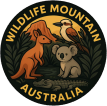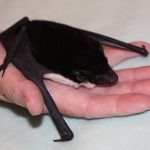YELLOW-BELLIED SHEATHTAIL-BAT
The Yellow-bellied Sheathtail-bat
In the fading light of dusk, when the last rays of the sun slip behind the horizon, a shadow cuts through the air with astonishing speed. Sleek and streamlined, the Yellow-bellied Sheathtail-bat emerges from its roost — a hollow deep within an old eucalypt — to begin its nightly hunt.
With fur as dark as midnight on its back and a soft wash of pale yellow or cream across its belly, this bat is built for both beauty and performance. Its long, narrow wings slice through the air like blades, designed for speed and agility. And hidden in the fine details of its anatomy lies the feature that gives it its name — a tail partially enclosed in a flexible membrane, forming a unique “sheath”.
Habitat and Range
The Yellow-bellied Sheathtail-bat is a true traveller of the Australian skies, ranging from lush coastal forests to the open woodlands of the interior and even into arid regions.
- Roosting spots: Tree hollows, caves, and occasionally buildings.
- Migratory behaviour: Travels vast distances in response to seasonal changes, following the ebb and flow of insect populations.
- Distribution: Found across much of mainland Australia, as well as parts of Papua New Guinea and nearby islands.
Life in Motion
Once airborne, this bat becomes a marvel of precision flight. Capable of reaching speeds of up to 60 km/h, it is one of Australia’s fastest bats. Its eyes are adapted for low light, but its true hunting weapon is invisible to us — echolocation.
By sending out rapid high-frequency calls, the Yellow-bellied Sheathtail-bat creates a sonic map of its surroundings. Insects too small for the human eye to catch are detected in mid-flight, then skillfully scooped from the air with a quick twist of its wings. Its diet includes:
- Moths
- Beetles
- Small flying insects
The Rhythm of Life
In the warmth of the Australian summer, the breeding season begins. After a gestation period of around three months, females give birth to a single pup. These tiny, hairless newborns are tucked safely against their mothers, nourished with milk until they are strong enough to take to the skies themselves.
While exact life spans in the wild remain uncertain, these bats are thought to live several years — provided they can avoid predators and environmental hazards.
Conservation Status and Challenges
At present, the Yellow-bellied Sheathtail-bat is listed as Least Concern on the IUCN Red List. Yet, its future depends on the health of the landscapes it calls home.
Key threats include:
- Habitat loss from land clearing and urban expansion.
- Climate change, altering insect availability and seasonal migration patterns.
Protecting roosting sites, preserving mature trees, and maintaining healthy insect populations are all vital if these bats are to continue their high-speed patrols over Australia’s night skies.
Their Place in the Ecosystem
The Yellow-bellied Sheathtail-bat is more than just a fascinating nocturnal acrobat — it is a silent guardian of balance. By consuming vast numbers of insects, it helps regulate pest populations, contributing to the health of both natural and agricultural systems.
When we protect this species, we are also safeguarding the intricate threads that weave together Australia’s ecosystems.
In the stillness of night, they fly unseen — swift, precise, and purposeful. To know the Yellow-bellied Sheathtail-bat is to appreciate yet another of the hidden wonders that call Australia home.



